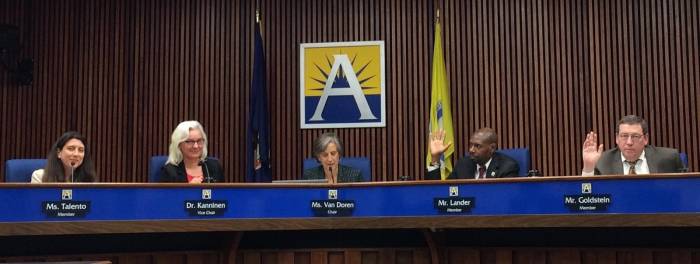Guest Blog By Will Driscoll, Arlington 350
School board members can be persuaded to vote “yes” for solar on schools, based on the experience of Arlington 350, in Virginia. Other local 350 groups may also find success with a solar-on-schools campaign, helped by low prices for installed commercial solar. (For Arlington 350, which launched early this year, this was our first campaign.)

Arlington Virginia’s School Board voted unanimously to create the authority to enter into solar power purchasing agreements, on April 20, 2017. From left: Tannia Talento, Barbara Kanninen, Nancy Van Doren, James Lander, and Reid Goldstein. (Photo credit: Will Driscoll)
Rooftops nationwide could accommodate 1,118 gigawatts of solar panels, which could meet 39 percent of current electricity demand, according to the National Renewable Energy Laboratory. The rooftops where solar is most economical are large commercial rooftops, like those on schools. And once a school system installs solar, the price becomes public information; given the recent dramatic price declines for solar, this price information can help influence private owners of commercial buildings to also “go solar.”
It is especially helpful to get solar installed on schools in a number of communities throughout a state. That makes it politically more difficult for the electric utility to implement high fixed fees or demand charges on utility bills, which would eat into the cost savings from solar installed anywhere in the utility’s service area. The more people who could complain about such proposed anti-solar fees, and the more distributed those people are across a state, the better.
In our campaign, we found some initial skepticism among Arlington’s five school board members, but ultimately helped win a unanimous vote for solar on schools. Specifically, the school board authorized school system staff to issue a request for proposals (RFP) for a solar power purchase agreement. The RFP is expected this October, followed by a contract award, and installation of solar panels in summer 2018.
Leading up to the school board vote, Arlington 350 supporters met individually with each school board member during their office hours (which were published on the school board website). The school board members’ comments revealed several concerns, and we developed a response for each one:
Some were concerned about the optics of paying a large sum of money for solar panels, while simultaneously cutting some educational expenses to achieve a balanced budget.
Our response: Under a power purchase agreement (PPA), the school system pays no upfront cost. Instead, a third party buys the solar panels, installs them on school rooftops, and operates and maintains them. The school system purchases the solar electricity, at a contracted cost that we expect will undercut the utility’s price for electricity—in which case the school system would save money from day one.
Some thought solar was still expensive (which it had been for decades).
Our response: Prices for installed commercial rooftop solar declined 20 percent in 2016 to $1.62 per watt. Moreover, if the school board found that the best PPA offer would not save the school system money on electricity, the school board could decline the offer.
One wanted to make sure that the school board would have the final say on any proposed solar power purchase agreement. Our response: We excerpted and highlighted language in the school system’s draft PPA resolution that guaranteed the school board the final say on any PPA agreement; emailed that information to school board members; and handed it to them as well at the school board meeting, before the vote.
In our individual meetings with school board members, we also heard positive comments—for example, regarding the educational value of rooftop solar to prime students’ interest in technology. We aimed for a unanimous vote to “go solar” because it would help persuade solar contractors to submit a PPA offer, knowing that the best offer would be highly likely to win a contract award from a supportive school board.
Allies in industry and government also played a key role. A major solar contractor had sent the school system an unsolicited proposal to install solar panels on schools, and sell the electricity to the school system at a very attractive price. (The same may be true for your school system.) The school superintendent favored solar on schools, and his staff had developed a solar-on-schools resolution ready for a school board vote. Other allies were Jay Fisette, chair of the county board (a separate entity from the school board), and the county board’s energy staff, which had identified two schools best suited for solar panels.
But even for a local 350 group that does not have such a strong set of solar-on-schools allies, the stars should still be aligned for getting solar on local schools, given the low and still-falling price of installed rooftop solar. Solar PPAs that save a school system money on the electric bill, while helping save the climate and getting students interested in technology, are a win-win-win.
For Arlington 350, we still have more work to do. The school system plans a first RFP for solar on only two of 30 schools that need it, leaving us with 28 schools to go. But first we are aiming to promote solar on schools in other Virginia school districts, to expand the political base of solar supporters, thus making it more difficult for the electric utility to impose anti-solar charges on everyone with rooftop solar.